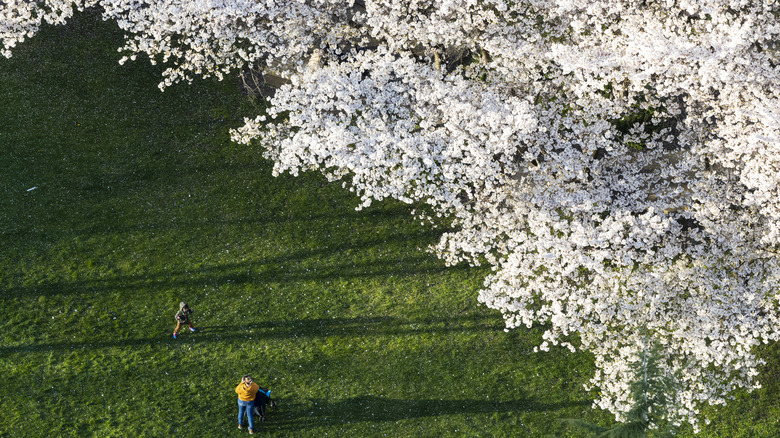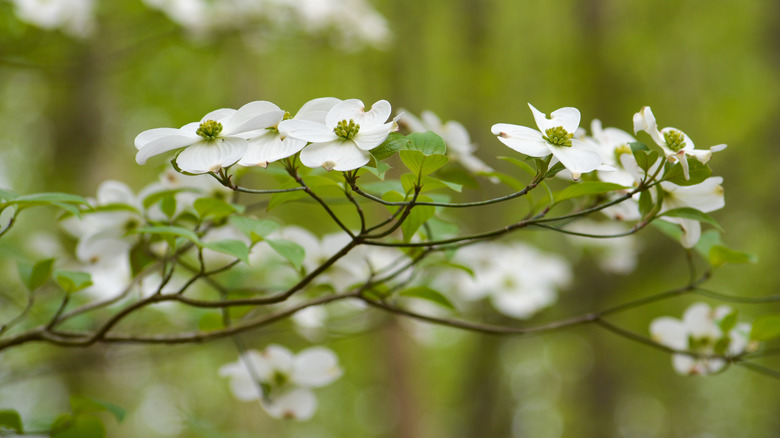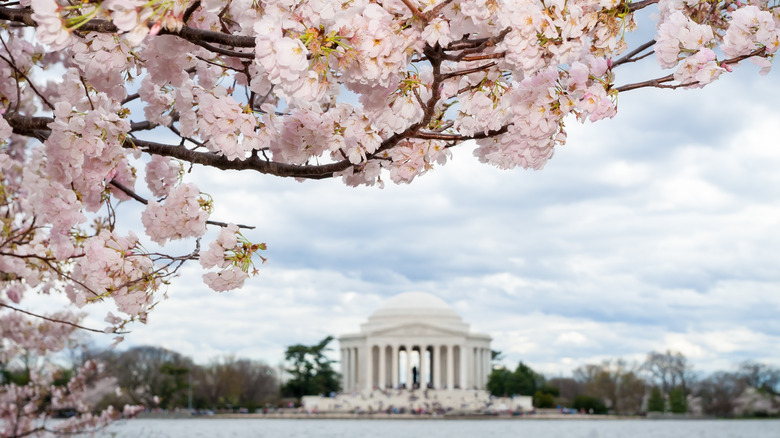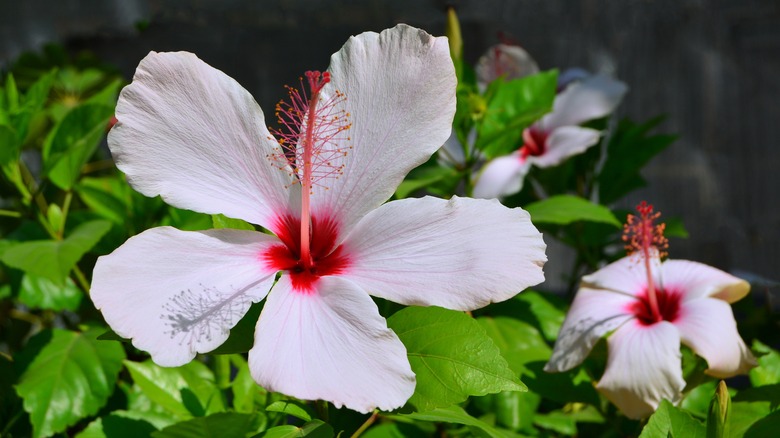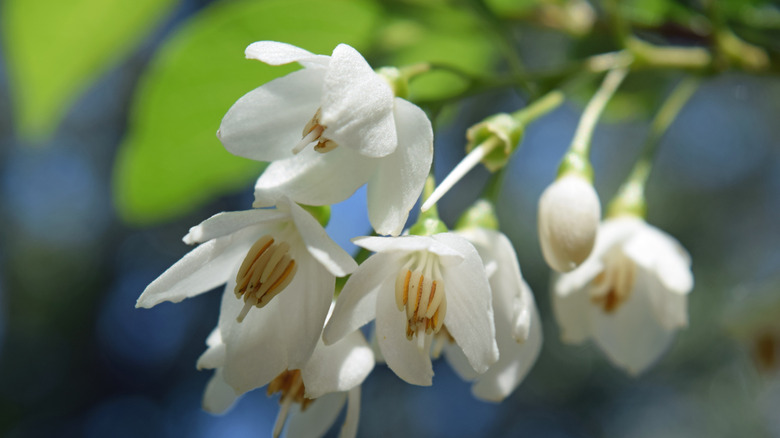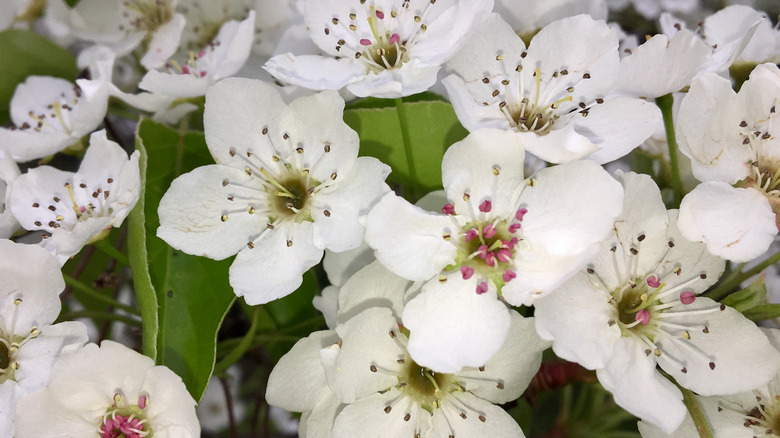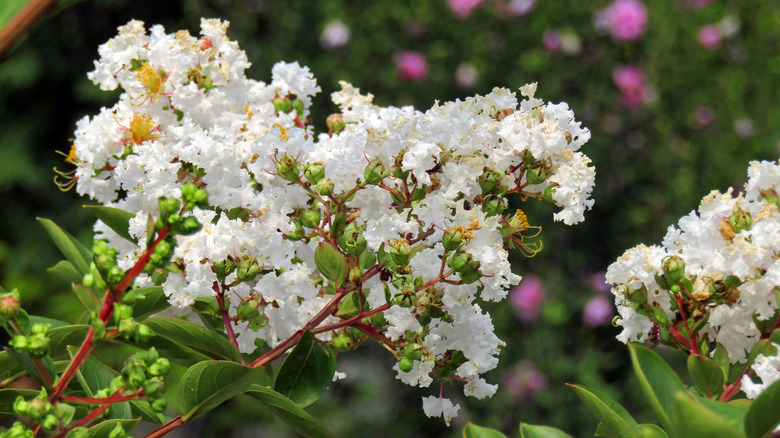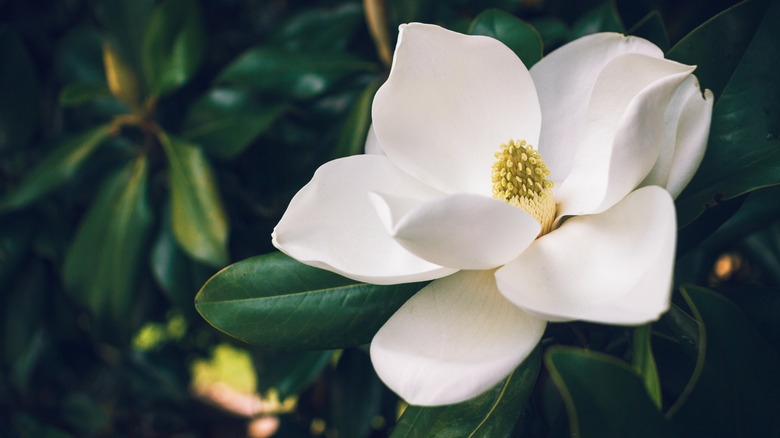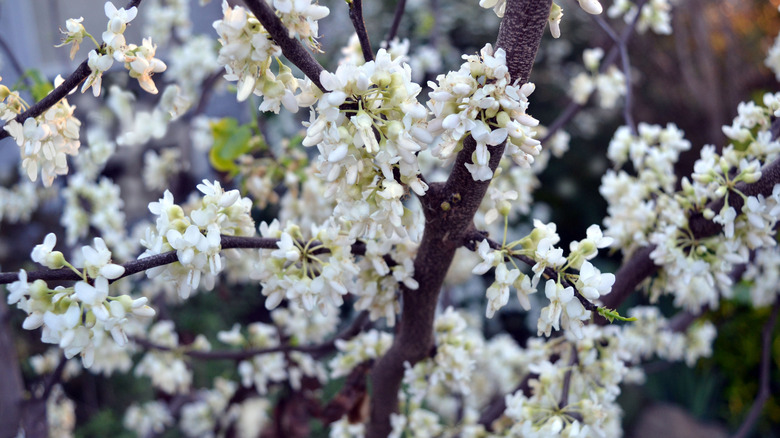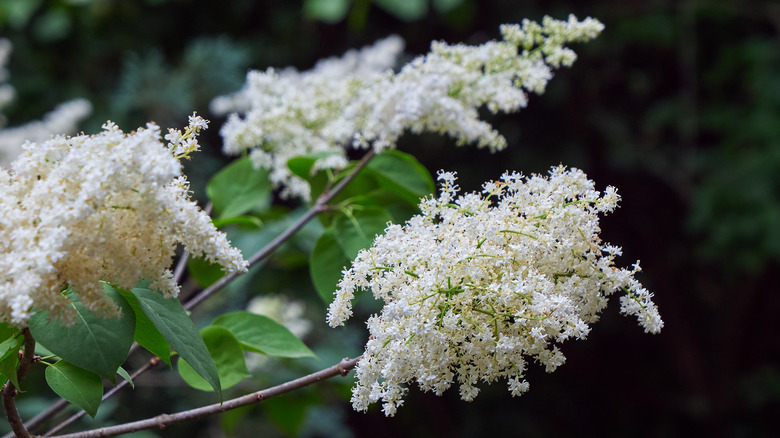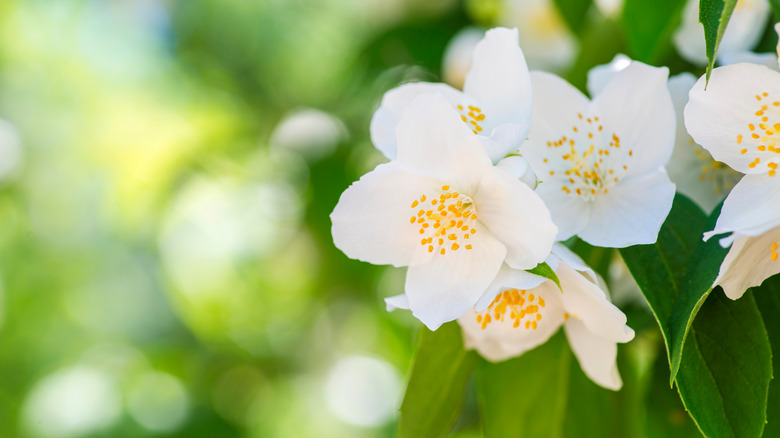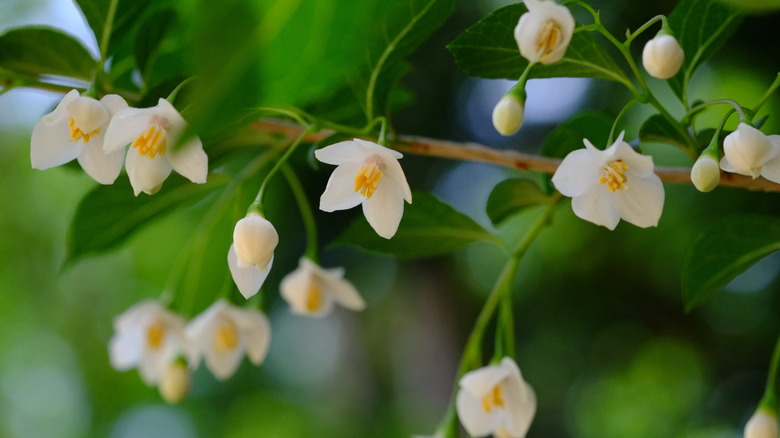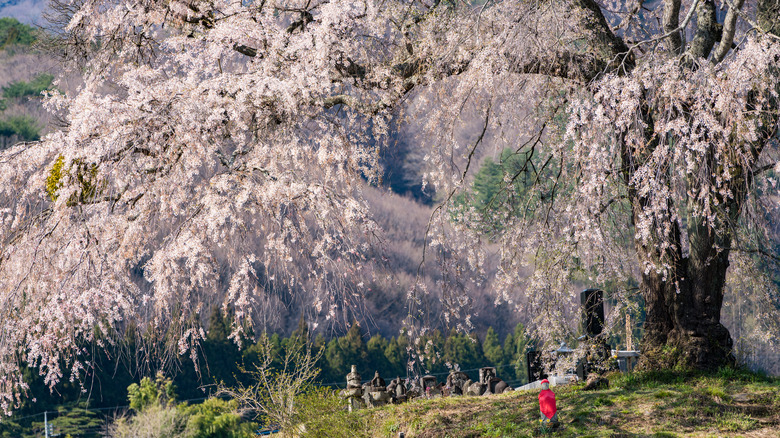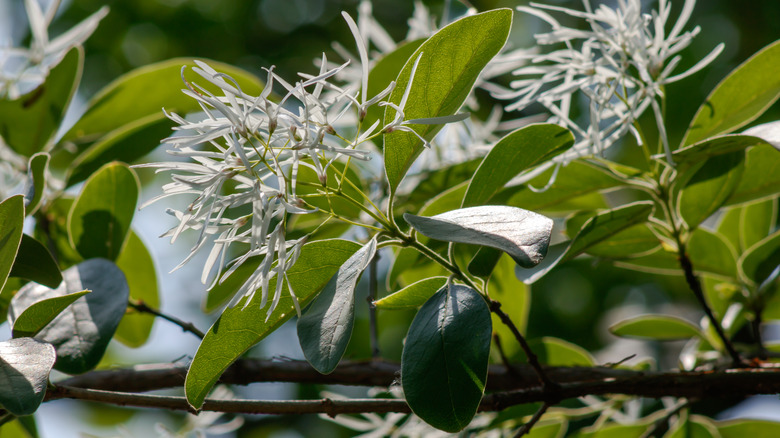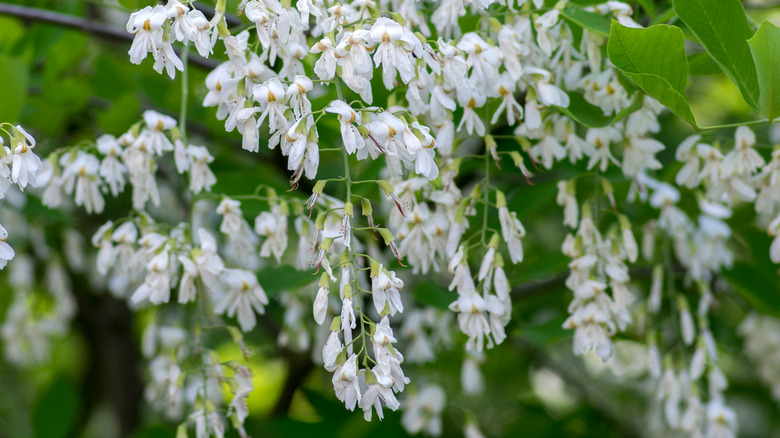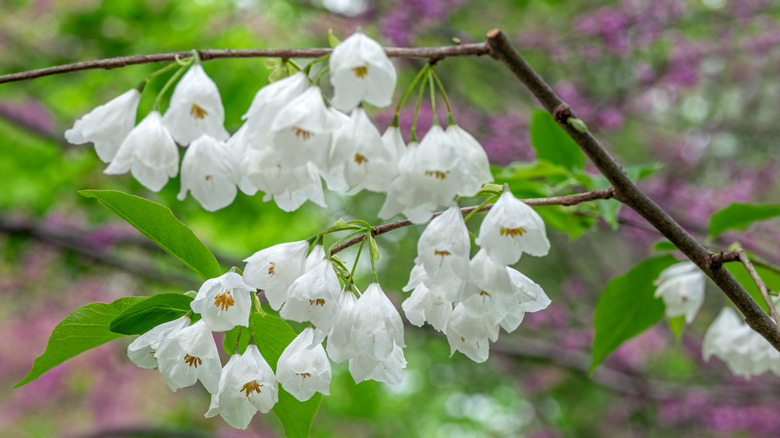15 Best Trees With White Flowers
As nature unfolds from its winter slumber every year, not only does the temperature change, but animals awaken and liven with the nicer days, and plants unfold into all their color and beauty that was previously held within. A signature touch of this alluring and elegant time of year is the proliferation of budding white flowers that emerge from numbers of branches and bushes. They accompany the warm greetings spring brings with a gentle touch of color into their surroundings.
Furthermore, symbolizing purity and innocence per Petal Talk, white flowers may just be that elegant touch your garden needs for your next blooming season. Although trees only show their white petals during their short blooming period, many trees with white flowers still look great year-round, despite their lack of flowers. Whether they attract wildlife to your yard or bless your eyes with crisp-colored leaves in the fall, some trees share beauty beyond their white, spring flowers. Helping you find the next elegant addition to your home garden, House Digest presents some of the best trees with white flowers for your next spring look.
1. White dogwood trees
Starting with one of the most popular trees in the United States, white dogwood trees (Cornus florida) are known for their easy maintenance and ability to grow in nearly any condition. Beyond their beautiful, four-petaled, white spring flower, they attract song birds and are great for accenting land, even growing next to patios or tall buildings, according to This Old House.
George Washington and Thomas Jefferson both had white dogwood trees on their plantations (per the Arbor Day Foundation).
Blooming Season: spring
USDA Growing Zone: 5 to 9
Growing Conditions: partial sun (at least four hours of direct sunlight per day)
Soil Type: acidic, loamy, moist, rich, or sandy; well-drained
Size: 15 to 25 feet tall, 25 feet wide
2. Yoshino cherry tree
Originating from Japan, the Yoshino cherry tree (Prunus yedoensis) was introduced to the United States in 1902. In the spring they produce gorgeous pink and white, almond smelling flowers, as noted by This Old House.
Yoshino cherry trees are spread across the Washington Monument area in Washington D.C., which were a gift from the mayor of Tokyo in 1912 (per the Arbor Day Foundations).
Blooming Season: spring
USDA Growing Zone: 5 to 8
Growing Conditions: partial to full sun
Soil Type: acidic, loamy, or moist; well-drained
Size: 30 to 50 feet tall, 25 to 40 feet wide
3. White rose of Sharon tree
The white rose of Sharon Althea tree (Hibiscus syriacus) is a type of hibiscus plant that produces elegant, white flowers instead of the more common red and orange ones. For these warm weather beauties, the tree is surprisingly easy to grow.
Because these tree like it warm and moist, it is best to layer their soil with mulch, but always water them down by the roots to prevent their foliage from collecting moisture, shares HGTV. The extra moisture could make them susceptible to fungal spores that could harm the plant.
Blooming Season: spring and summer
USDA Growing Zone: 5
Growing Conditions: partial to full sunlight
Soil Type: moist, well-drained
Size: 8 to 12 feet tall, 6 to 10 feet wide
4. Washington hawthorn tree
Beyond their pearly, white spring blossom, Washington hawthorn trees (Crataegus phaenopyrum) share their beauty year-round, especially in the fall when their leaves turn a variety of beautiful colors, including orange, scarlet, crimson, and purple.
Washington hawthorns are also a rather small tree, best fit for a small home garden, per The Spruce.
Blooming Season: late spring and early summer
USDA Growing Zone: 5 to 9
Growing Conditions: full sun
Soil Type: well-drained
Size: 25 to 35 feet tall, 25 to 35 feet wide
5. Spring snow crabapple tree
The spring snow crabapple tree (Malus) is known for its snowy, white spring blossoms that cover every inch of their branches. When the flowers drift into the warm spring breeze, the tiny petals look like falling snow.
According to Arbor Valley, the spring snow crabapple tree does not grow fruit, unlike most crabapple trees, leading to a mess-free environment around the tree.
Blooming Season: spring
USDA Growing Zone: 3 to 7
Growing Conditions: full sun
Soil Type: well-drained, moderately moisture
Size: 25 to 30 feet tall, 15 to 20 feet wide
6. Natchez crape myrtle tree
Beloved by many southern states, like Georgia and South Carolina, the Natchez crape myrtle tree (Lagerstroemia natchez) is another tree with clusters of white flowers that last all summer long (via The Spruce).
According to the Arbor Day Foundation, the word "crape" in this tree's name came from the shape of their tiny white flowers, which look like crepe paper.
Blooming Season: summer
USDA Growing Zone: 6 to 10
Growing Conditions: partial to full sunlight
Soil Type: adaptable
Size: 20 to 30 feet tall, 15 to 20 feet wide
7. Southern magnolia tree
The southern magnolia tree (Magnolia grandiflora) is a large, evergreen tree with broad dark green leaves and white summer flowers (per Fast Growing Trees). The North Carolina Extension Gardener Plant Toolbox mentions the strong fragrance these creamy white flowers produce. Along with their strong smell, they also bloom from late spring to the peak of fall, lasting all summer long.
Although the flowers are beautiful and scented, southern magnolias tend to grow very large. Also, their dense, dark leaves are both difficult to manage and tend to kill everything growing underneath them.
Blooming Season: late spring, early summer
USDA Growing Zone: 7 to 9
Growing Conditions: full sun
Soil Type: adaptable
Size: 60 to 80 feet tall, 40 feet wide
8. Royal white redbud tree
The royal white redbud tree (Cercis canadensis) buds abundantly with small white blossoms every spring. According to Planting Tree they are safe and will thrive anywhere you decide to place them.
Ideally, it is best to place a royal white redbud tree where you can see it, like by a window or patio; therefore, you can watch them grow and bloom throughout the year.
Blooming Season: spring
USDA Growing Zone: 4 to 9
Growing Conditions: partial to full sun
Soil Type: adaptable
Size: 20 to 30 feet tall, 15 to 30 feet wide
9. Japanese lilac tree
Japanese lilac trees (Syringa reticulata) blossom with clusters of little, white, fragranced flowers every spring (per The Morton Arboretum). This tree has shrub-like branches that are connected by a single, thick trunk in the center. They grow into a naturally attractive shape, decreasing the amount of maintenance you have to do.
According to Gardening Know How, although the Japanese lilac tree only blossom for two weeks, it fills the gap between spring and summer when spring blossoms have ended and summer blossoms are only budding.
Blooming Season: late spring, early summer
USDA Growing Zone: 3 to 7
Growing Conditions: full sun
Soil Type: moist, well-drained
Size: 20 to 30 feet tall, 15 to 25 feet wide
10. Sweet tea Gordlinia tree
Famous for their 5-inch white flowers, sweet tea Gordlinia trees (Gordlinia grandiflora) are both beautiful and delightful smelling. According to Southern Living, the foliage is semi-evergreen, but the big white flowers are only summer blooming.
Although there are a variety of soils this tree can grow in, the soil should remain moist for the best results. Constant soggy soil, however, will not help the plant thrive (per Wilson Bros Gardens).
Blooming Season: summer
USDA Growing Zone: 7 to 10
Growing Conditions: partial to full sun
Soil Type: moist, well-drained
Size: 20 to 30 feet tall, 8 to 10 feet wide
11. Japanese snowbell tree
Japanese Snowbell trees (Styrax japonicus) are perfect for planting along a hillside or slope due to their small but strong stature and cute, white, bell-shaped flowers that bloom during the early summer (via Monrovia).
The North Carolina Extension Gardener Plant Toolbox mentions that Japanese snowbell branches are very commonly made into walking sticks due to the tough wood they are made from.
Blooming Season: early summer
USDA Growing Zone: 5 to 8
Growing Conditions: partial to full sun
Soil Type: moist, acidic, well-drained
Size: 20 to 30 feet tall, 20 to 30 feet wide
12. Weeping cherry tree
Similar to weeping willow trees, weeping cherry trees (Prunus pendula) have vine-like stems that droop from strong upper branches. But instead of green foliage, weeping cherry trees ignite with pure white and pink blossoms when spring rolls around (per Family Handyman).
This tree could be a new, unique addition to your garden, but beware of the temperatures that can affect the health of this tree. Fast Growing Trees recommends covering your tree with a frost blanket if temperatures drop to -10 degrees Fahrenheit or less in your area.
Blooming Season: spring
USDA Growing Zone: 4 to 9
Growing Conditions: full sun
Soil Type: loose, well-drained
Size: 20 to 30 feet tall, 20 to 30 feet wide
13. American fringe tree
The American fringe tree is an olive related tree, native to the eastern United States. It originated in the state of Missouri, then branched out to the rest of the United States. It is known for its fragrant clusters of white flowers that bloom in the springtime, as noted by the North Carolina Extension Gardener Plant Toolbox.
Piedmont Master Gardeners mentions that although the American fringe tree grows at a very slow rate, their blossoms are still worth the wait.
Blooming Season: late spring
USDA Growing Zone: 4 to 9
Growing Conditions: partial to full sun
Soil Type: moist, occasionally dry, well-drained
Size: 12 to 30 feet tall, 12 to 20 feet wide
14. American yellowwood tree
The American yellowwood tree is another slow-growing tree that is underappreciated for its many deserving qualities that range from landscaping to shade on a hot day, suggests HGTV.
During their blooming seasons, American yellowwood trees illuminate with white, fragranced, pea-like flowers. These flowers hang in clusters from the tree, each being around 15 inches in length (per the University of Kentucky).
Blooming Season: spring
USDA Growing Zone: 4 to 8
Growing Conditions: full sun
Soil Type: loamy or sandy; moist, well-drained
Size: 30 to 50 feet tall, 40 to 55 feet wide
15. Carolina silverbell tree
Native to the Southern Appalachian Mountains, the Carolina silverbell tree blossoms with cute, snowy white flowers that hang down from its branches like little bells (per the Missouri Botanical Garden). In nature, these trees are usually found among mountains, hills, or slopes.
If you're looking for a new tree to accent your yard, the Carolina silverbell tree is easy to maintain, small in size, and fits great at the edge of a woodland boarder, as noted by the University of Kentucky.
Blooming Season: spring
USDA Growing Zone: 4 to 8
Growing Conditions: partial to full sun
Soil Type: rich, moist, acidic, medium well-drained
Size: 30 to 40 feet tall, 20 to 35 feet wide
